DANCE CLASS
CONTENTS: PAGE 1 | PAGE 2 | PAGE 3 | PAGE 4 | PAGE 5 | PAGE 6
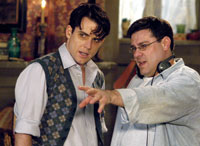 |
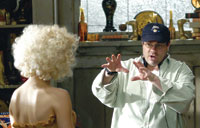 |
| Above: Director Andy Fickman with Christian Campbell; Below: Fickman with Amy Spanger. |
(director, Reefer Madness):
Reefer Madness was anything but normal from start to finish. I found directing a movie musical full of multiple tricky challenges above and beyond the normal process — yet by the end I realized, like making any movie, preproduction and rehearsal time saved my ass over and over again.
From the first day of preproduction I made the decision to throw all of the key department heads in Musical Theater & Film 101. I wasn’t sure how familiar they were with the rich history of movie musicals, so I wanted to equalize us all and give us a shared base of knowledge. Every morning we gathered in the conference room and spent hours reviewing movie musicals that my choreographer, Mary Ann Kellogg, and I felt were relevant. This became a rite of passage for the department heads — a morning ritual that I refused to let go of — and the payoff was huge. By the time we started filming, I had the most well-versed crew in musicals I could have imagined. We almost abandoned making the movie in favor of starting our own community-theater company and staging My Fair Lady, but when we discovered that none of our uncles owned barns that we could convert into a stage for the big show, we chucked the whole idea and went back to making the movie.
Another big roadblock was recording song long before we would ever film the scene. It was a Catch-22. Actors got cast — arrived for the first day of rehearsal and within hours had to be taken to the recording studio to lay down their vocal tracks. Some of our cast had been with the show from the beginning onstage, so diving into the song was slightly easier than for those who were newer to the Reefer family. I had to try to create a world in the recording studio in which the actors had a sense of the action and many times the emotion of the scene itself. Easier said than done. The actors proved to be amazing, and thankfully we found ourselves rerecording only a few bits of songs as we progressed through production.
Scheduling a musical is a task one should not take lightly. We were blessed with an amazing first a.d. and producer who made magic happen whenever possible. But we had seven-day workweeks from start to finish. Film [for] five [days]. Rehearse the dances on the weekend as well as go into the recording studios to complete music. This meant exhausted actors, so we really had to maximize our use of everyone’s time. Plus, I figured they could sleep when the movie was wrapped. If anyone complained, I informed them that I was going to be their body double for their dancing — I’m not sure what it was, but seemingly they were all fearful that a short squatty Jew was not the best person to body-double for them. Actors and their egos… go figure. If I didn’t have the consistent groin-pull problem, I am sure I would have been asked to join Riverdance.
MICHAEL KANG
(writer-director, The Motel):
Making a feature is a monster. To try and fit all the ways making The Motel has changed me, my life, my perception of reality and my faith in humanity in just two short blurbs would be almost as hard as actually making the film. But having been one of those longtime readers of Filmmaker who would pore over each issue looking for clues to the mystery of how someone actually gets a film made, I guess I can share two pieces of information that I didn’t really understand until I made my own film.
The first is that at some point you just have to decide to make the film. There was a moment during that limbo between prep and preproduction when nothing was solid. Cast, crew, money, health — everything was up for grabs. It was at that particular low point where I had a moment of clarity. I had completely stressed myself out for almost a year about every aspect of the production that wasn’t in place. I had spent months trolling the playgrounds of Chinatown looking for a chubby 13-year-old Chinese boy to carry the lead role in the film; at that point I wasn’t even close to finding anyone. None of the financing was solid. None of the key crew was in place. I didn’t even have an inkling of an idea of how to get a motel to shoot in, and the film is called The Motel. But it was at that point that I realized that I have little or no control over all of these external elements; the only thing I can control is myself. And it was then that I realized my only responsibility was to make the best possible film I can. I realized that I couldn’t make anyone give me money. I couldn’t make an actor or crew appear. I couldn’t build a motel to shoot in. And on top of that, none of those things were my direct responsibility. I was only responsible for being ready when those things happen. It was then that a great weight was lifted from my shoulders. It was also very soon after that when everything started to miraculously fall into place.
The second thing I learned was that no two films in the history of cinema have ever gotten made the same way. There is absolutely no way to prepare for it.
RIAN JOHNSON
(writer-director, Brick):
I have a huge family, and we’re all very close. When I was a kid we’d spend our holidays together, and my cousins, brothers and I would spend the entire vacation making movies. Brick is my first feature, my first time working with professional actors and a full crew, and I think I expected it to be very different from my handmade approach to filmmaking. So if one thing blindsided me during the production, it was how close in spirit the experience was to making those old family movies. Our cast and crew became like a family, and it was a big relief for me to find that there was no trick to directing on this scale. I didn’t have to learn how to be a hard-ass or manipulate people; I could just gather together some amazingly talented people and treat them the way I treated my family — to try and create an atmosphere of trust, love and appreciation. If I just did that — and made sure the lens cap was off — things would just work out fine.
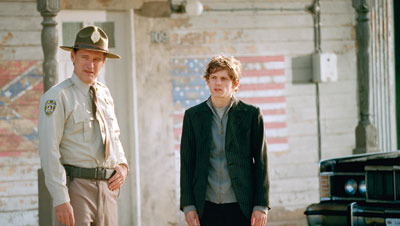 |
| Dear Wendy |
(director, Dear Wendy)
The biggest decision I can make as a director is whether I’m going to do a film or not — 80 percent of my work is to find the right project. Celebration was very much based on characters, and It’s All About Love was very much about what was going on around all of the characters. Dear Wendy was more of a return to home for me — it’s an ensemble film. It’s not a Dogme 95 film — it’s not handheld, it’s normally lit and shot on a huge set — but it’s quite focused on the story and on the characters. It’s Dogme-like.
At the same time, much about this film was unfamiliar. It was the first one I didn’t write — it was written by Lars von Trier, and we’re so opposite as directors. It also deals with a group of boys and their fascination with firearms, and that subject matter in itself was difficult for me because I grew up as a hippie kid on a commune.
This film was a great thing for me to do. There was less responsibility; there was less weight on my shoulders; there wasn’t this huge artistic pressure. It was a very positive experience, a very energetic experience. We had a group of extraordinary, fantastic actors. And I wasn’t destroyed by a year of writing.
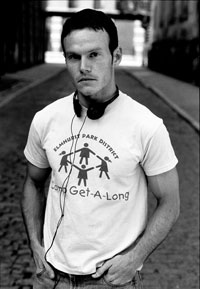
director Chris Terrio | CHRIS TERRIO
(writer-director, Heights): When my short films are shown on the big screen, inevitably someone leaves the room to go and throw up. I think this is because I was trained mostly in documentary, and my camera tends toward motion sickness — always wandering, jumping into a swish-pan here, finding focus there, relentlessly probing people’s faces for their thoughts and never still for a second. In the case of Heights, though, the challenge I set for myself (and for Jim Denault, the d.p.) was to jettison all my usual party tricks and to let the camera be as non-invasive and as objective as possible. From the beginning, I felt that the story required the camera to disappear, as all the characters are in some way opaque, they’re all hiding something, and we are never really allowed inside anyone’s head until the very end. So the psychologically probing lens was out. |
I decided, then, to try and play tennis with the net up for once, to draw chalk outlines and stay within those limits as the story progressed. Then, as night falls in the film’s 24-hour span and the worlds of the characters fall apart, the tennis net breaks a bit, the chalk lines are smeared, and we begin stepping outside the stylistic boundaries drawn at the beginning. That was the idea, anyway. But, that said, I’m looking forward to the next film, which will be more psychologically and stylistically searching, so I can watch someone run out to the lobby and vomit again.
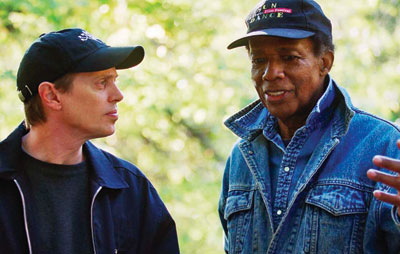 |
| Steve Buscemi and director William Greaves. |
(writer-director, Symbiopsychotaxiplasm: Take 2 1/2 ):
Having survived the mad dash to complete Symbiopsychotaxiplasm: Take 2 1/2 in time for Sundance 2005, what have I learned from this admittedly unorthodox filmmaking experience? Well, for one thing, never throw good footage away — especially if it’s Kodak 16mm color reversal stock. Apparently, this stuff can survive the worse treatment imaginable and still be in excellent shape 35 years later. The trick, of course, is for the filmmaker to survive in fairly decent shape as well. In any case, three decades after shooting what was to be a cycle of five feature films under the “Symbio” umbrella and after a series of fortuitous circumstances, not the least of which was the encouragement and support of Steven Soderbergh and Steve Buscemi, Symbio 2 1/2 is finally seeing the light of day. As Buscemi says in the film, it may be the first time that a sequel to an unreleased film has been produced. We’ll see what happens next.
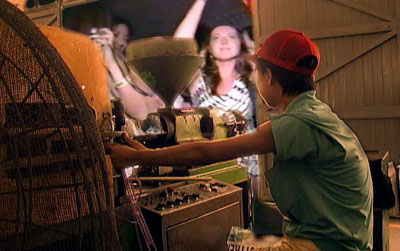 |
| Mardi Gras: Made in China |
(director, Mardi Gras: Made in China):
I learned how difficult it is to start and finish a documentary, but I also learned that the documentary is never finished. The film will have a life even after I die. Second, I was surprised to learn how many “professional” filmmakers didn’t want to help or offer advice except, “Go to film school,” yet I was surprised by the number of “amateurs” who did help. Third, I was startled that my film got into Sundance given that I’ve never had a film class and that I taught myself how to edit by making Mardi Gras: Made in China. Additionally, the acceptance into Sundance indicates — to me — that independent, low-budget filmmakers can achieve their goals and compete with high-budget filmmakers. Fourth, I did not expect to lose ten to 13 pounds during the process of making Mardi Gras: Made in China, but I did lose the weight because I ate mostly peanut butter and jelly sandwiches.
TIM KIRKMAN
(writer-director, Loggerheads):
In Loggerheads, each of the three geographical regions of North Carolina — the mountains, the Piedmont and the coastal plain — operates like a different character and supports each of the three storylines. The heart of the conflict within the stories is a red state/blue state divide, and the truth about North Carolina is that internally it sort of embraces this conflict across its regions. So it was more important to me that we get this right; I didn’t want to create a caricature of the regions.
One of the challenges was establishing the three regions without actually moving the production across the state. Most of the principal photography was shot in and around the Wilmington area, with a day and a half of shooting near Asheville.
Initially, I thought it would be impossible to create three believable worlds at the coast. The vegetation, the quality of light, the landscape, the wildlife — they’re each so different depending on where you are in the state. But it just wasn’t feasible to move production. So we started thinking about how to make the best use of what was available to us and try to get some second-unit pickups to help establish the variations between them.
What I discovered was that with a lot of planning and some strategic choices, it was possible to manipulate Wilmington rather easily. Working with Oliver Bokelberg (d.p.), the location department and the art department, we were able to transform our hero’s house at the coast into a traditional-looking mountain home in Asheville. A few second-unit shots from the Piedmont town of Eden were all we needed to make the geographic leap.
ANTHONY NG
(writer-director, 212):
I was born and raised in Hong Kong and came to New York to attend NYU Film School. After I completed my studies, I began conceptualizing the screenplay for 212. As an Asian filmmaker, I almost felt obligated to make an Asian-American-theme film, either a social commentary about Asians’ role in America or one about the generation gaps within the community. But at the same time, I felt that the genre has been done so many times that I wanted to break out of the mold and do something really unique and different. So I decided to make a film that I wanted to make: a story about relationships set in NYC. After 212 was completed, I discovered that because of its urban themes, the film is not just about New Yorkers but about people living in cities all over the world, which is, in retrospect, the story I truly wanted to tell. And although the subject of the film is not about Asian Americans, the tone of the film is decidedly Asian; 212 is minimalist in terms of dialogue, and the characters in the film learn to appreciate what is absent or non-apparent in their relationships. By being honest with myself, I felt I had finally found the creative voice I’ve been looking for.
CONTENTS: PAGE 1 | PAGE 2 | PAGE 3 | PAGE 4 | PAGE 5 | PAGE 6
VOD CALENDAR


 See the VOD Calendar →
See the VOD Calendar →


